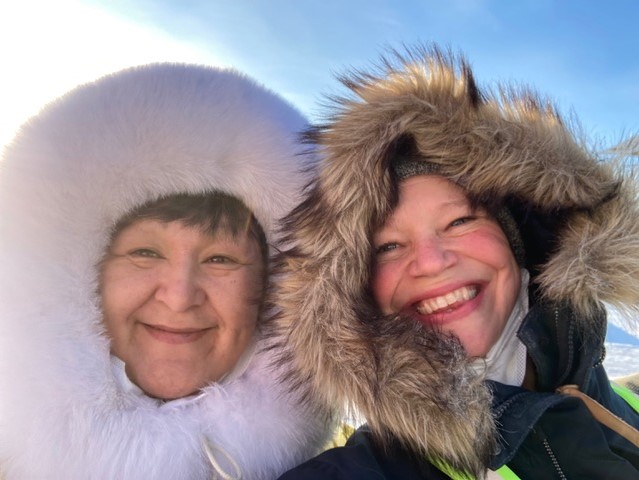MINTO – Puvirnituq is a village of about 1,500 people in the Nunavik territory of northern Quebec. A six-hour plane ride from Montreal, it is located beyond the tree line at the mouth of Hudson’s Bay.
The village is accessible only by air and any roads end at the village limits. To travel beyond you need an airplane, a snowmobile or a dog sled.
“It’s baffling to imagine anyone ever settling there. I mean the environment is so incredibly hostile,” said Minto midwife Amy Sjaarda, who recently returned from a nine-week stint helping expectant mothers in Puvirnituq and the surrounding region.
Sjaarda points out most residents of the community “have been living there for generations and generations.
“They either work for the Township of Puvirnituq or they work for the health care alliance, so in the hospital,” Sjaarda explained.
“The community is pretty much 100 per cent Inuit, so it’s an Indigenous community.”
She added, “There are local Indigenous midwives there, but for the most part people have support jobs. So the health care providers are all imported from out of town,” while community members do “whatever jobs are available.”
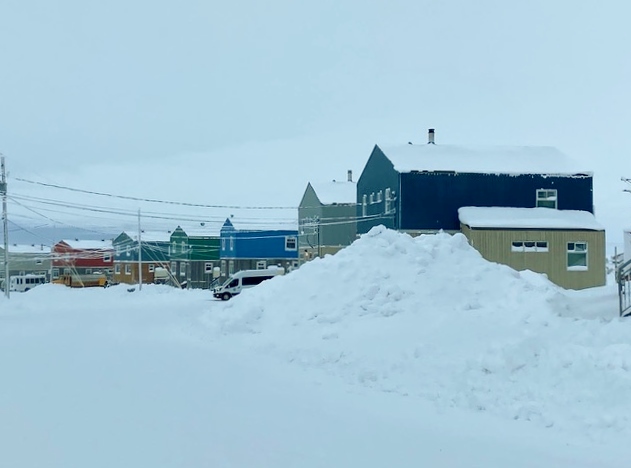
The snow covered streets of Puvirnituq, where winter temperatures average minus 30 degrees and feel like minus 45 with windchill.
Sjaarda, became a midwife in 2010 and works with Countryside Midwifery Services.
Born in Listowel, she grew up in Ingersoll and moved to Minto with her husband, Don, and their two children about a decade ago.
“My education program is through Laurentian University up in Sudbury and the last two and a half years of the midwifery program are clinical placements in various midwifery clinics and it’s a lottery system, so you sort of end up where they put you,” she explained.
“And we ended up actually down in Perth County, which is the sister clinic to the Minto clinic here (in Palmerston), so that’s how I discovered midwifery in this community.”
The opportunity to go to Puvirnituq came through the Canadian Association of Midwives.
Sjaarda explained the association regularly puts out requests for midwives “to do contact placements up there because, while there are local midwives, which is very unique, there’s not quite enough to cover their on-call schedule. So they need to supplement the call schedule with midwives.
“It just interested me.”
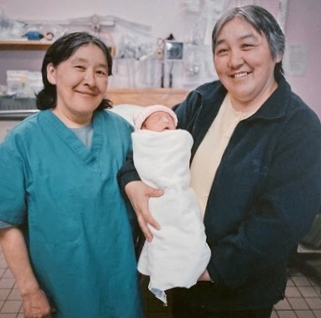
Two Puvirnituq midwives who founded the local midwife program.
While the experience of working in a remote community was new to her, Sjaarda did some research to learn what to expect.
“I spoke to a lot of other midwives who’ve done similar placements in similar areas and lots of different opportunities,” she said.
“The Northwest Territories has opportunities, northern Ontario, northern Quebec, and they’re all a little different and I wanted to go to a place where they were keeping families together for the birthing experience, so they were keeping births local instead of shipping them south four weeks before their due date.”
Arriving in Puvirnituq on Dec. 28, she stayed until March 1.
Puvirnituq is unique among communities in the region in that it has a hospital.
“Most of the other small communities along the Hudson’s Bay coast don’t have that. They might have a nurse practitioner or a doctor that flies in and out, but otherwise they don’t have much health care,” Sjaarda explained.
During the nine weeks she was there, Sjaarda assisted in about 20 births, compared to a pace of about eight a month in her regular practice.
Most of the births she assisted with happened at the local hospital.
“People would come in, they would travel in from the various surrounding villages a few weeks before their due date and stay in the local community and then have their birth there, stay for a few days and then go home again,” she explained.
Occasionally circumstances required her to attend a birth in an outlying community.
“On the occasions that I needed to go to another village to help out it was always by plane,” she notes.
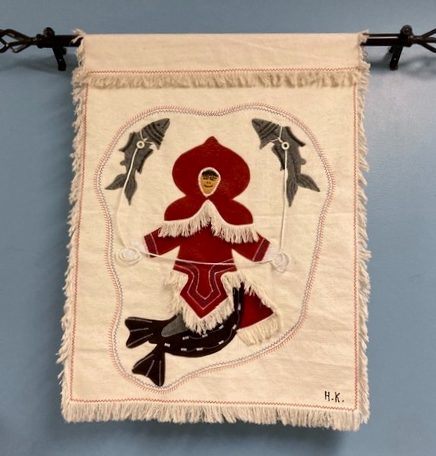
Traditional Inuit art covers the walls of birthing suite at the hospital in Puvirnituq. “It makes women feel more at home and comfortable,” says Minto resident Amy Sjaarda, who recently spent nine weeks working as a midwife in the northern Quebec community.
The remote nature of the community presented unique challenges for Sjaarda in her work.
“Any access to emergency assistance is six hours or three plane rides away. So if you run into trouble, you have to recognize it quickly and do something about it and if need be transport sooner than I would here,” she said.
“Here I have the luxury of patience and time … trying this and trying that. There, if things aren’t working, you pretty much had to transport way sooner.”
On one memorable occasion, Sjaarda found herself assisting with a difficult birth via video conference.
“It was a breech delivery,” she recalled. “Normally that would be a C-section delivery, but it was happening too quickly.”
The mother was in a remote village and delivering early.
“And there was no health care provider there who’d ever delivered a baby and then delivering a breech baby is even more complicated,” she said.
“I was the only health care provider in the whole community who’d ever delivered a breech baby. So I basically instructed them how to do it over the video conference … and it worked well.”
She added the experience was “a different twist on the idea of a Zoom meeting.”
After the baby was born, said Sjaarda, “a bunch of us hopped in a small plane and flew to that community and collected the mom and the baby and brought them back to the larger centre for a bit of observation because the baby was early.”
Sjaarda found she was well received among the local midwives and health care providers she worked with.
“The secret is always not to walk in saying ‘I’m going to change this and this and this,’ but to walk in saying, ‘I’m here to support you. What do you need?’ And in that regard, we had we had very good relationships.”
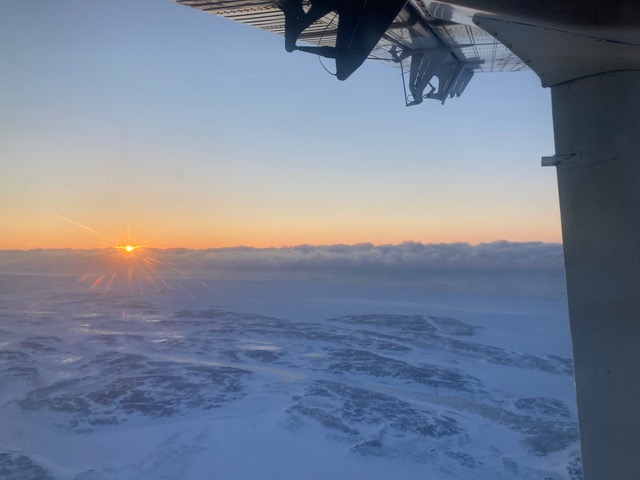
A spectacular view of the tundra in the Nunavik territory of northern Quebec from the air.
While her work kept her busy most of the time, Sjaarda did get a chance to check out the area around the village.
“On the occasions that I had a bit of time to myself, I did bring my cross country skis, so I would go explore the bay that way,” she said.
“But I was warned very early on to always keep the village in sight, because if a storm whips up and you’re far out, it’s almost impossible to find your way home.”
At the time Sjaarda was in northern Quebec, temperatures averaged -30C, with windchill pushing to -45.
“If I took my gloves off to take a picture, my hands were frozen very quickly and my phone would shut down within a few seconds of being out of the pocket,” she recalls.
Short stretches in the extreme cold were enough for Sjaarda, who quickly ruled out joining with local residents on excursions like fishing trips.
“They talked about going on fishing trips, and I said, ‘Oh, I’d love to do that.’
“They’re like, ‘You’re from the south. There’s no way you could do that,’ because basically, they would ride on a skidoo for four hours, go fishing and then ride for four hours home in minus 40 degree weather.”
However, she notes, for the locals, such trips were more than recreational.
“People really stick to a lot of their traditional ways, which was amazing to observe,” she said.
“They still do most of their own hunting, whether it’s fish or beluga, or caribou or ptarmigan. And that’s the only way, I think, families can really afford to eat, because food is so expensive up there.”
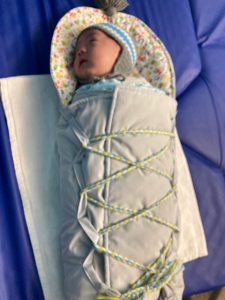
Mothers in Puvirnituq use traditional ways of wrapping and carrying their babies.
The only restaurant in Puvirnituq closed during the pandemic and Sjaarda experienced plenty of sticker shock at the local grocery store.
“I would go in and pick up five things and end up spending over $50 … a container of milk, a slice of cheese, a handful of vegetables, a box of cereal,” she recalls.
The northern lifestyle presented plenty of other challenges for a visitor, said Sjaarda.
“The infrastructure is so different; because of course they can’t dig septic systems or wells or anything, or basements for that matter, because of the permafrost. So all the houses are on stilts and they have to bring in any water you use and ship out any waste,” she pointed out.
“Normally I think the town that I was in has four waste trucks. But due to various reasons they were down to one serving an entire village. So we could go for 10 days without being able to flush a toilet or put any water down the sink or anything like that.”
Sjaarda was fortunate her accommodations were right across the road from the hospital.
“I could just walk over to the hospital for any water needs … to take a shower, or go to the bathroom. I could do dishes and just dump the water outside,” she explained.
“But eventually, after a certain amount of time, that water shuts off too. So it was it was definitely a challenge. You come to appreciate just the simple act of flushing a toilet.”
In addition, said Sjaarda, like in many Indigenous communities, “there was almost always a boil-water advisory.
“So I would boil my water and then I would put it through a Brita filter,” she explained.
Despite the hardships of their remote lifestyle, Sjaarda says the people she lived among loved to laugh.
“Just sitting in the office space with the group of women from that community and just hearing their laughter” is among her favourite memories.
“It was all in Inuktitut, so I didn’t necessarily understand what they were saying or laughing about, but hearing the laughter was such an enjoyable experience.”
The plane trips to other parts of the region were also something Sjaarda enjoyed.
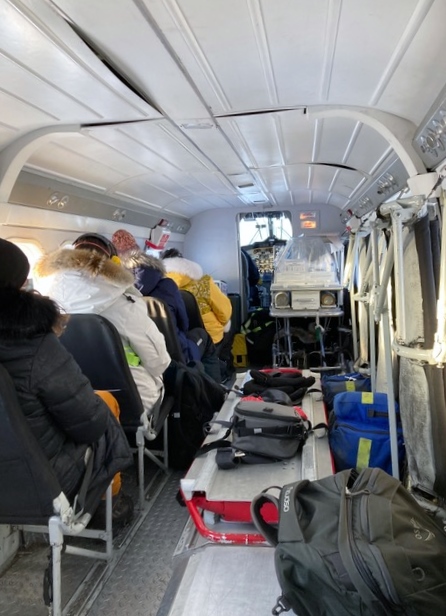
Inside the Twin Otter plane carrying midwife Amy Sjaarda, a student midwife and several nurses en route to pick up a new mother and baby.
“I was very lucky in that none of my Evac flights were serious medical emergencies. So I was fortunate in that I got sort of the easy ones,” she said.
“They were daytime ones, so I basically got to fly in an awesome little float plane, see the tundra, which is spectacular … see other little villages, pick up some people and then head back home.
“So I think because I just didn’t happen to have one that was a massive emergency, it felt it felt like it was a fun part of the adventure.”
Sjaarda feels her time in the north was a learning experience and she returned with “a bit more confidence” in her own capabilities.
“Up there I was the expert. Here we have doctors and OBs and specialists of any sort readily available. So if anything’s just slightly out of the norm I can consult, I can talk to people,” she said.
“Up there, there wasn’t that ability … I think I just managed a lot more emergencies than I do down here.”
While Sjaarda said she would consider signing up for another northern experience down the line, she would probably look for a shorter stint, noting nine weeks was “way too long to be away from my family.”
She said she would also eventually like to try other types of work/travel opportunities.
“Doctors Without Borders is always something in the back of my mind; maybe for once the kids are older. That would be a very different experience as well, but that would be interesting and something I sort of have my eye on,” she said.
“It’s good when you’ve been doing something for a long time to challenge yourself to learn something new, to do something different.”




